CTRC Breakthroughs
Thermal Interfaces
Research Topics
Microscale Transport and Microchannels
Electrically Actuated Microscale Flows
Thin-Film Transport, Wicks and Heat Pipes
Novel Air and Impingement Cooling Approaches
Surface and Interface Engineering
Thermal Materials R&D
Thermal Interfaces
Small-Scale Refrigeration
Exploratory and Novel Concepts
Renewable and Sustainable Energy
Optimization of Thermal Interface Material’s Particle Features and Dispense Mechanism for Enhanced Heat Dissipation
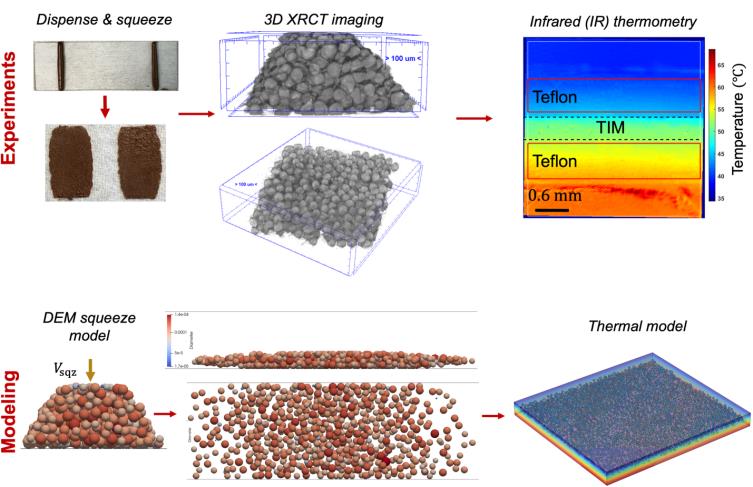 Thermal interface materials (TIMs) improve thermal
contact in electronics packages. For TIMs consisting
of particles suspended in a polymeric matrix, the
particle networks within the material evolve through
the assembly process. There is a lack of quantitative
understanding of particle rearrangements within the
TIM induced by these assembly processes and the
resulting effect on the thermal performance during
operation. The objective of this project is to
fundamentally understand the impact of particle
redistribution within the TIM during dispense and
squeeze processes on the thermal conductivity,
through experimental and modeling approaches. Experimentally, X-ray micro computed tomography (XRCT)
provides insight into the distribution of particles before and after squeezing. In parallel, an open-source
software, MFIX, was modified to simulate constant velocity squeezing of TIMs with a one-way fluid-particle
coupling via drag force. A finite element thermal conduction model was developed using COMSOL to predict
bulk TIM thermal conductivity. Ultimately this project is the first step in developing both experimentallyvalidated microstructure and thermal models that can be used to optimize TIM formulation and application
process.
Thermal interface materials (TIMs) improve thermal
contact in electronics packages. For TIMs consisting
of particles suspended in a polymeric matrix, the
particle networks within the material evolve through
the assembly process. There is a lack of quantitative
understanding of particle rearrangements within the
TIM induced by these assembly processes and the
resulting effect on the thermal performance during
operation. The objective of this project is to
fundamentally understand the impact of particle
redistribution within the TIM during dispense and
squeeze processes on the thermal conductivity,
through experimental and modeling approaches. Experimentally, X-ray micro computed tomography (XRCT)
provides insight into the distribution of particles before and after squeezing. In parallel, an open-source
software, MFIX, was modified to simulate constant velocity squeezing of TIMs with a one-way fluid-particle
coupling via drag force. A finite element thermal conduction model was developed using COMSOL to predict
bulk TIM thermal conductivity. Ultimately this project is the first step in developing both experimentallyvalidated microstructure and thermal models that can be used to optimize TIM formulation and application
process.
TIM Design for Optimized Thermal and Mechanical Properties
 While, in general, increasing particle loading is required to meet the expected target of effective thermal conductivities, the increased effective elastic modulus due to increased particle loading, which together with the thinned dies has the potential to cause warping or fracture of the dies. Thus, there is a need to carryout systematic thermal-mechanical design trade-off studies of the particle filled thermal interface materials (TIMs). Thermal conduction behavior and flow behavior are directly related to particle filler loading. Microstructures with ultrahigh volume fractions are needed to effectively predict the behavior of the particulate systems. In this project, we have successfully generated microstructures with ultrahigh volume fractions and analyzed the effective thermal conductivity and elastic modulus of these TIMs with high particle loading. The analysis has also been extended to TIMs with ellipsoidal fillers.
While, in general, increasing particle loading is required to meet the expected target of effective thermal conductivities, the increased effective elastic modulus due to increased particle loading, which together with the thinned dies has the potential to cause warping or fracture of the dies. Thus, there is a need to carryout systematic thermal-mechanical design trade-off studies of the particle filled thermal interface materials (TIMs). Thermal conduction behavior and flow behavior are directly related to particle filler loading. Microstructures with ultrahigh volume fractions are needed to effectively predict the behavior of the particulate systems. In this project, we have successfully generated microstructures with ultrahigh volume fractions and analyzed the effective thermal conductivity and elastic modulus of these TIMs with high particle loading. The analysis has also been extended to TIMs with ellipsoidal fillers.
Polymer-Metallic Hybrids for Thermal Interface Applications
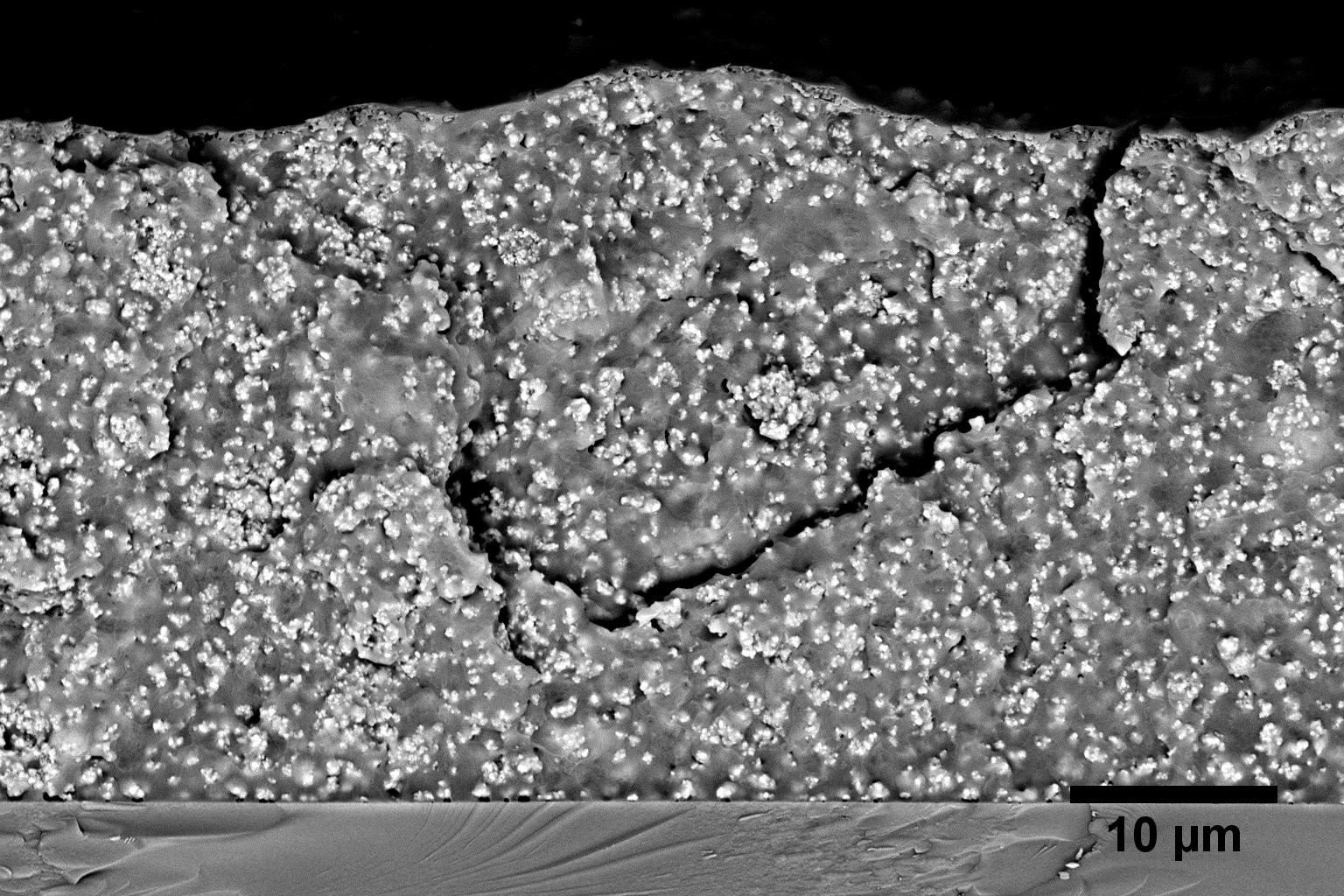 Polymer-based thermal interface materials (TIMs) filled with thermally conductive particles are generally used in electronic devices. However, mismatch in the coefficient of thermal expansion (CTE) is a common problem, causing thin film delamination during a system’s lifecycle. In order to develop polymer-metallic TIMs, this project emphasized the balance between mechanical and thermal performance. We investigated various physical effects of polymer-based TIMs to access mechanical and thermal reliability. We also achieved various TIMs with different types of materials, which were nanoparticles and microporous foam as conductive networks.
Polymer-based thermal interface materials (TIMs) filled with thermally conductive particles are generally used in electronic devices. However, mismatch in the coefficient of thermal expansion (CTE) is a common problem, causing thin film delamination during a system’s lifecycle. In order to develop polymer-metallic TIMs, this project emphasized the balance between mechanical and thermal performance. We investigated various physical effects of polymer-based TIMs to access mechanical and thermal reliability. We also achieved various TIMs with different types of materials, which were nanoparticles and microporous foam as conductive networks.
Dry Contact Thermal Conductance Enhancement
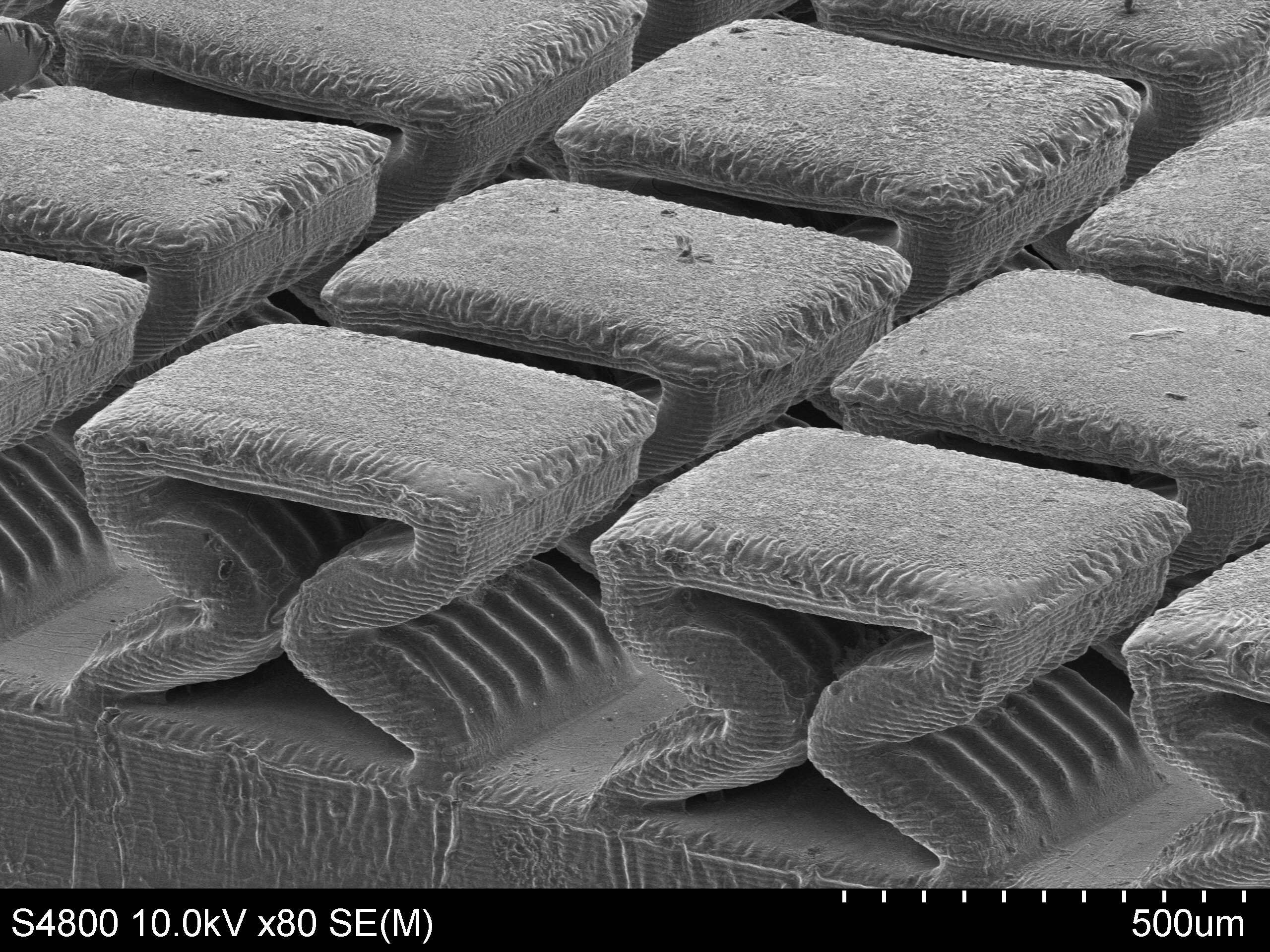 Thermal interface materials (TIMs) are commonly used to enhance thermal conductance across interfaces. However, wet TIMs and high compressive pressures are disallowed for ‘pluggable’ applications where the devices need to frequently slide into contact with the heat sinks. In this project, we developed a compliant dry TIM which can enhance the thermal conductance between nonflat and rough mating surfaces at a very low pressure of ~20 kPa. This TIM consists of an array of metallized polymer micro-springs which are fabricated using cost-effective micro-stereolithography (μSL) based techniques and electroless metal plating. Even for rough and nonflat interfaces, the dry TIM is able to achieve a thermal resistance equivalent to contact between highly polished and very flat surfaces (~300 mm2·K/W). The mechanical robustness of the dry TIM was evaluated, and the performance demonstrated when placed between pluggable optical module and its riding heat sink.
Thermal interface materials (TIMs) are commonly used to enhance thermal conductance across interfaces. However, wet TIMs and high compressive pressures are disallowed for ‘pluggable’ applications where the devices need to frequently slide into contact with the heat sinks. In this project, we developed a compliant dry TIM which can enhance the thermal conductance between nonflat and rough mating surfaces at a very low pressure of ~20 kPa. This TIM consists of an array of metallized polymer micro-springs which are fabricated using cost-effective micro-stereolithography (μSL) based techniques and electroless metal plating. Even for rough and nonflat interfaces, the dry TIM is able to achieve a thermal resistance equivalent to contact between highly polished and very flat surfaces (~300 mm2·K/W). The mechanical robustness of the dry TIM was evaluated, and the performance demonstrated when placed between pluggable optical module and its riding heat sink.
Porous Metal Thermal Interface Material
 Metal foam structure has been shown to have good
mechanical compliance and relatively higher thermal conductivities making
it an ideal candidate for thermal interface material in
electronics cooling applications. Analytic
models were developed in order to predict apparent thermal and mechanical performance of the material generalized with respect to raw
material properties and porous geometries such as porosity and pore size.
Model predictions were validated through numerical simulations and correlated to the experimentation,
with which we refined the ASTM standard measurement setup and
additionally developed a new setup to take into account the
deformation information.
Additionally, multiple composite designs with phase change
material and thermal greases were tested with regards to their
effective thermal and mechanical properties were analyzed.
Metal foam structure has been shown to have good
mechanical compliance and relatively higher thermal conductivities making
it an ideal candidate for thermal interface material in
electronics cooling applications. Analytic
models were developed in order to predict apparent thermal and mechanical performance of the material generalized with respect to raw
material properties and porous geometries such as porosity and pore size.
Model predictions were validated through numerical simulations and correlated to the experimentation,
with which we refined the ASTM standard measurement setup and
additionally developed a new setup to take into account the
deformation information.
Additionally, multiple composite designs with phase change
material and thermal greases were tested with regards to their
effective thermal and mechanical properties were analyzed.
Three-Dimensional Graphene Networks Facilitate Efficient Heat Conduction at Thermal Junctions
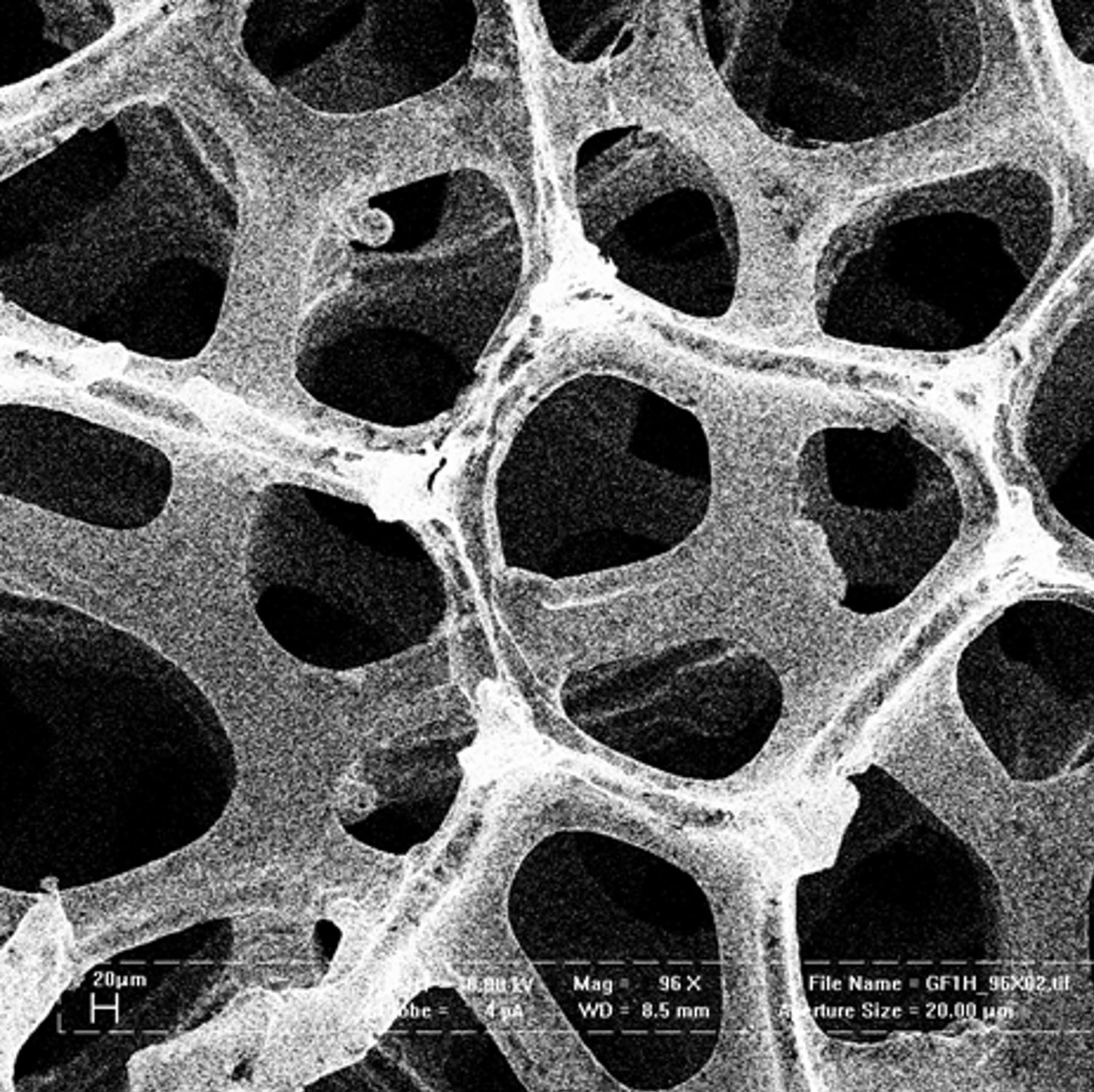 Efficient heat dissipation becomes a crucial issue due to increase in
generated power density in modern electronic devices. Therefore,
high-performance TIMs are required to achieve efficient heat
conduction across thermal junctions (heat sources/sinks) by
filling in surface irregularities. In this project, graphene
networks prepared by chemical vapor deposition method were
investigated as thermal interface materials. The thermal resistance was characterized between graphene
networks and copper. The result indicates that graphene networks
can improve the heat transfer at interfaces between dissimilar
materials. Researchers also conducted systematic studies on thermal interface
resistance of graphene networks with various densities and
demonstrated their feasibility as thermal interface materials.
In addition, researchers investigated mechanical properties such
as compressive strength.
Efficient heat dissipation becomes a crucial issue due to increase in
generated power density in modern electronic devices. Therefore,
high-performance TIMs are required to achieve efficient heat
conduction across thermal junctions (heat sources/sinks) by
filling in surface irregularities. In this project, graphene
networks prepared by chemical vapor deposition method were
investigated as thermal interface materials. The thermal resistance was characterized between graphene
networks and copper. The result indicates that graphene networks
can improve the heat transfer at interfaces between dissimilar
materials. Researchers also conducted systematic studies on thermal interface
resistance of graphene networks with various densities and
demonstrated their feasibility as thermal interface materials.
In addition, researchers investigated mechanical properties such
as compressive strength.
Impedance-Based Visualization of Voids in Thermal Interface Materials
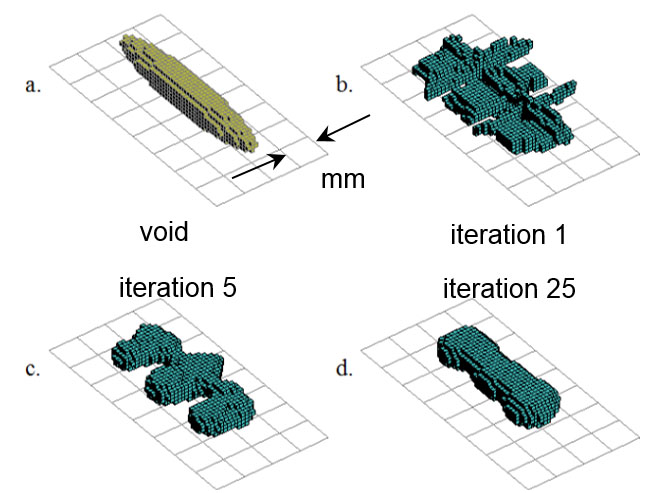 Thermal interface materials are an essential component of thermal
management of modern electronics systems. These materials tend
to degrade over time, reducing their effectiveness at conducting
heat. The application of capacitance imaging to the size scale
of a thermal interface material (~1 cm x ~1 cm x ~0.01 cm)
represents an innovative development for experimental
instrumentation. The technique may be used by researchers to
better understand the behavior of thermal materials subjected to
various stress conditions or as a quality control technique.
Embedded electrical sensors have been successfully used in a lab
environment to image either a thin layer of thermal grease or a
thick thermal pad while it is situated between two opaque
surfaces. Bubbles and other defects in the material may be
detected and imaged using image reconstruction algorithms.
Thermal interface materials are an essential component of thermal
management of modern electronics systems. These materials tend
to degrade over time, reducing their effectiveness at conducting
heat. The application of capacitance imaging to the size scale
of a thermal interface material (~1 cm x ~1 cm x ~0.01 cm)
represents an innovative development for experimental
instrumentation. The technique may be used by researchers to
better understand the behavior of thermal materials subjected to
various stress conditions or as a quality control technique.
Embedded electrical sensors have been successfully used in a lab
environment to image either a thin layer of thermal grease or a
thick thermal pad while it is situated between two opaque
surfaces. Bubbles and other defects in the material may be
detected and imaged using image reconstruction algorithms.
Designing Transient Liquid Phase Sintering Systems for Power Electronics
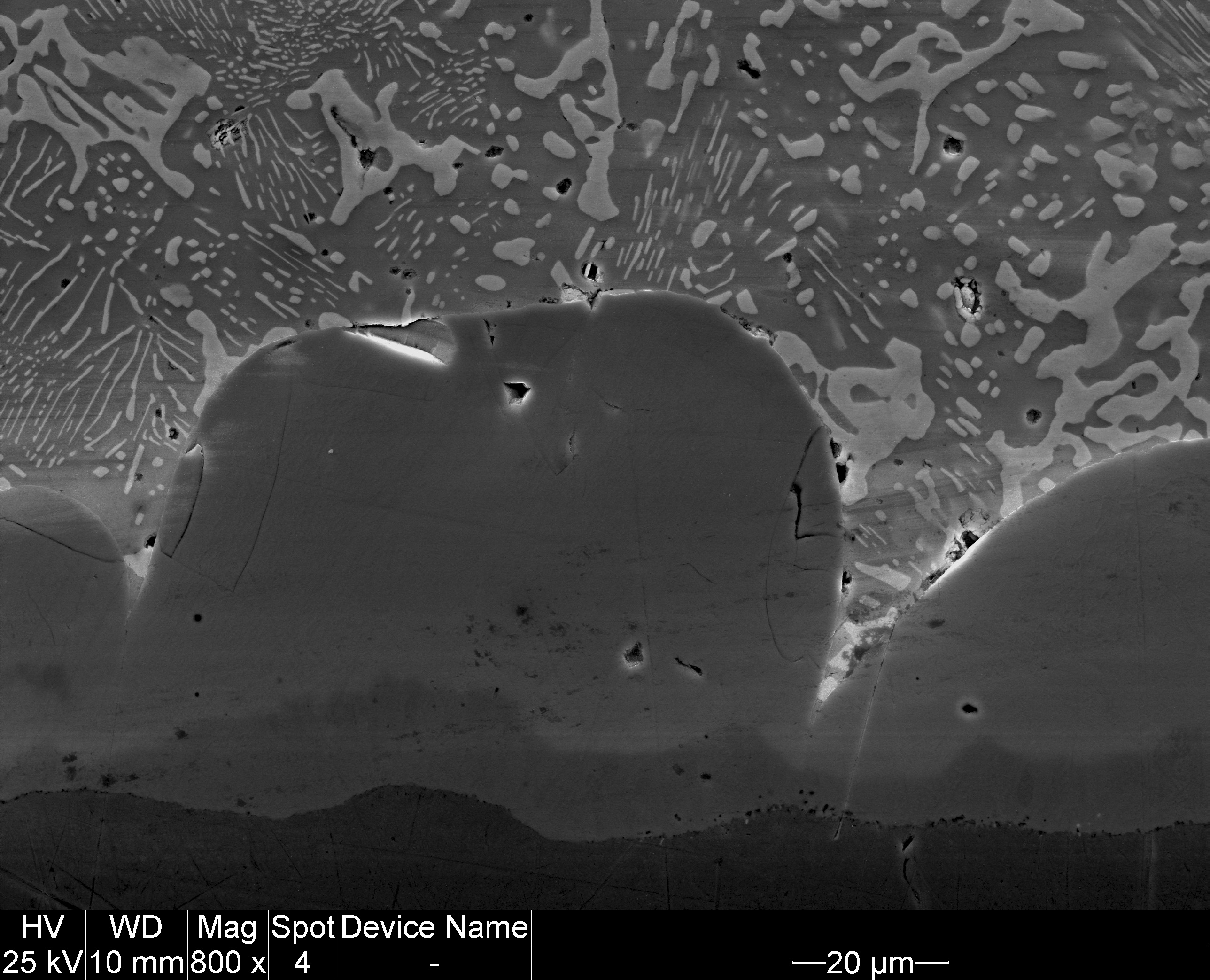 In transient liquid phase sintering, a low melting temperature
metal powder and an organic flux are mixed with high melting
point alloys in particle form. When the temperature is increased
above the melting temperature of the low melting point phase, a
new compound begins to form at the interface between the liquid
and the solid. This project developed model paste formulations
for the development of new electrical and thermal technology
based on transient liquid phase sintering for attaching cooling
systems to chips, semiconductor dies, and substrates in power
electronics. Thermodynamic software and down-selection criteria
for specific applications were developed and applied to evaluate
novel alloy formulations for these uses.
In transient liquid phase sintering, a low melting temperature
metal powder and an organic flux are mixed with high melting
point alloys in particle form. When the temperature is increased
above the melting temperature of the low melting point phase, a
new compound begins to form at the interface between the liquid
and the solid. This project developed model paste formulations
for the development of new electrical and thermal technology
based on transient liquid phase sintering for attaching cooling
systems to chips, semiconductor dies, and substrates in power
electronics. Thermodynamic software and down-selection criteria
for specific applications were developed and applied to evaluate
novel alloy formulations for these uses.
Flexible Foam New Thermal Interface Material
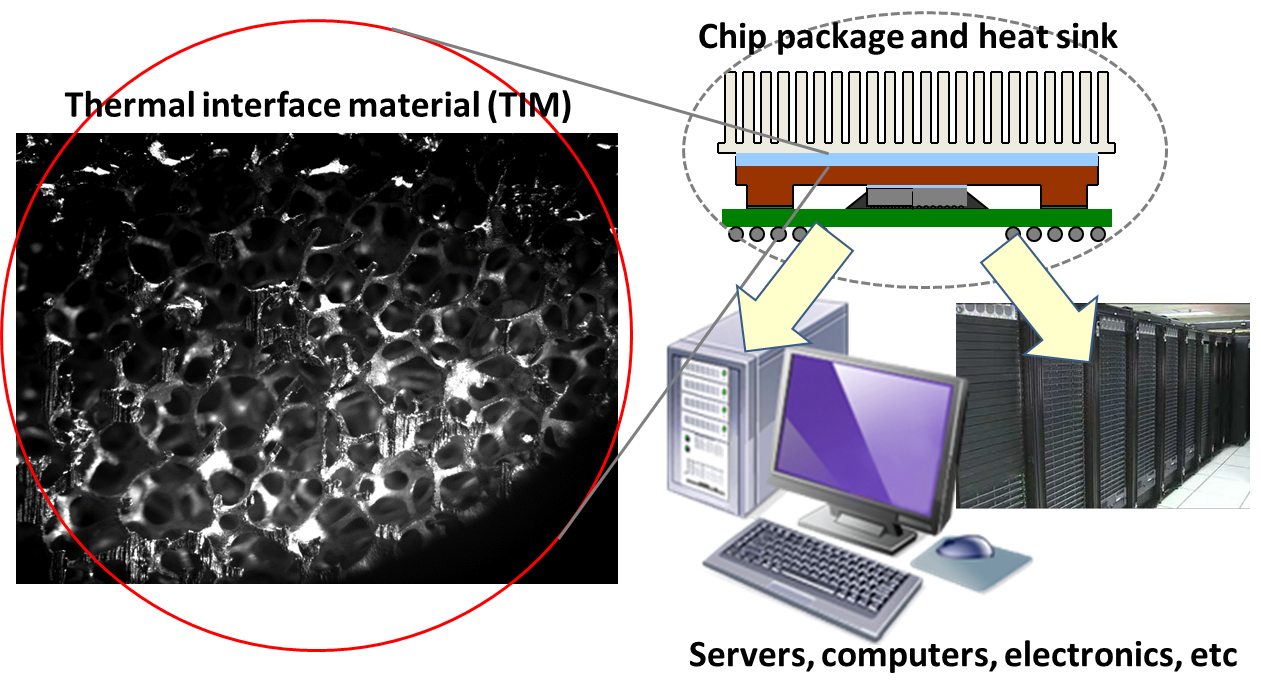 This project developed a new set of analytic models to predict the
performance of porous aluminum structure (foam) as a thermal
interface material. The models include the mechanical compliance
and the effective thermal conductivity of the foam by a
combination of physical model validated with numerical and
experimental data. The developed model aids in selecting the
best geometry with the combination of materials in foam
structure, which will ultimately enable the industry with the
most cost effective solution for electronics cooling. The chart
including the microscope image of the sample foam shows the
example of placement and method to utilize the aluminum foam in
the electronic cooling.
This project developed a new set of analytic models to predict the
performance of porous aluminum structure (foam) as a thermal
interface material. The models include the mechanical compliance
and the effective thermal conductivity of the foam by a
combination of physical model validated with numerical and
experimental data. The developed model aids in selecting the
best geometry with the combination of materials in foam
structure, which will ultimately enable the industry with the
most cost effective solution for electronics cooling. The chart
including the microscope image of the sample foam shows the
example of placement and method to utilize the aluminum foam in
the electronic cooling.
Graphene-Based Thermal Interface Materials
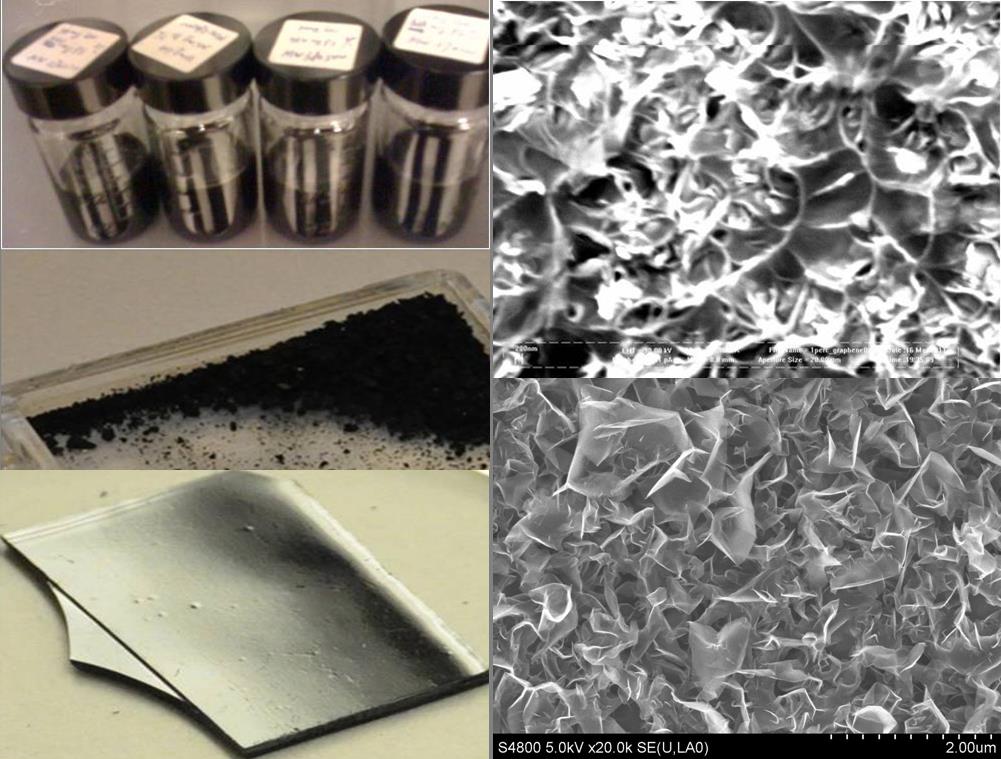 Graphene, a single atomic layer of graphite with honeycomb lattice
structure, exhibits very high thermal conductivity (~3000-5000
W/m-K), which renders it an outstanding candidate for Thermal
interface materials (TIMs) applications. Graphene composite
shows significant increase of thermal conductivity when the
volume percent of graphene is increased. Vertically grown
graphene shows superior performance, with a thermal resistance
in the order of 1 mm2 K/W, which is better than
available commercial thermal interface materials. This figure is
the synthesis of graphene composite, which includes the
preparation of graphene solution, the drying of the powders, and
the hot pressing to form nanocomposite. Shown in the right lower
corner is the vertical graphene petals prepared using chemical
vapor deposition (CVD).
Graphene, a single atomic layer of graphite with honeycomb lattice
structure, exhibits very high thermal conductivity (~3000-5000
W/m-K), which renders it an outstanding candidate for Thermal
interface materials (TIMs) applications. Graphene composite
shows significant increase of thermal conductivity when the
volume percent of graphene is increased. Vertically grown
graphene shows superior performance, with a thermal resistance
in the order of 1 mm2 K/W, which is better than
available commercial thermal interface materials. This figure is
the synthesis of graphene composite, which includes the
preparation of graphene solution, the drying of the powders, and
the hot pressing to form nanocomposite. Shown in the right lower
corner is the vertical graphene petals prepared using chemical
vapor deposition (CVD).
Performance and Reliability of Thermal Interface Materials
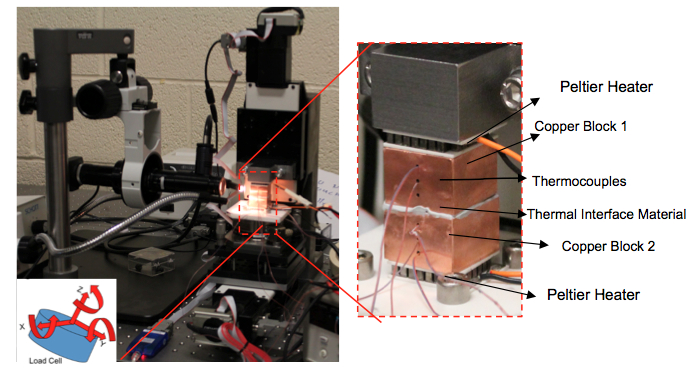 This project has developed a test procedure to simultaneously
characterize thermal and non-Newtonian flow behavior of
polymeric thermal interface materials (TIMs). Also, reliability
characterization of representative polymeric TIMs using the
developed test procedure after exposure to high temperature bake
as well as thermal cycling of the materials. The picture depicts
the custom built equipment meant for the reliability testing of
thermal interface materials. Simultaneous non-Newtonian flow and
thermal conductivity characterization can be conducted using
this setup. Such a capability allows monitoring of flow response
as well as thermal conductivity change of TIMs subjected to
complex environmental conditions such as bake or thermal cycle.
This project has developed a test procedure to simultaneously
characterize thermal and non-Newtonian flow behavior of
polymeric thermal interface materials (TIMs). Also, reliability
characterization of representative polymeric TIMs using the
developed test procedure after exposure to high temperature bake
as well as thermal cycling of the materials. The picture depicts
the custom built equipment meant for the reliability testing of
thermal interface materials. Simultaneous non-Newtonian flow and
thermal conductivity characterization can be conducted using
this setup. Such a capability allows monitoring of flow response
as well as thermal conductivity change of TIMs subjected to
complex environmental conditions such as bake or thermal cycle.
Impedance-Based Visualization of Voids in Thermal Interface Materials
 This method provides a new way to test the effectiveness of the
thermal pastes used for keeping computer chips at appropriate
temperatures during operation.The project utilizes parallel
arrays of electrodes to form a square grid around the
interfacial gap. Capacitance measurements taken at the crossing
points of the grid allow for anomalies in the thermal interface
material to be detected. The figure shows the measuring device
using copper rods imbedded into two clear panels. Rods on one
panel criss-cross with the rods of the other panel.
Electrical measurements can determine whether there are bubbles
or cracks in the material between the panels.
This method provides a new way to test the effectiveness of the
thermal pastes used for keeping computer chips at appropriate
temperatures during operation.The project utilizes parallel
arrays of electrodes to form a square grid around the
interfacial gap. Capacitance measurements taken at the crossing
points of the grid allow for anomalies in the thermal interface
material to be detected. The figure shows the measuring device
using copper rods imbedded into two clear panels. Rods on one
panel criss-cross with the rods of the other panel.
Electrical measurements can determine whether there are bubbles
or cracks in the material between the panels.
Performance and Reliability Impact of Compliant Thermal Interface Materials
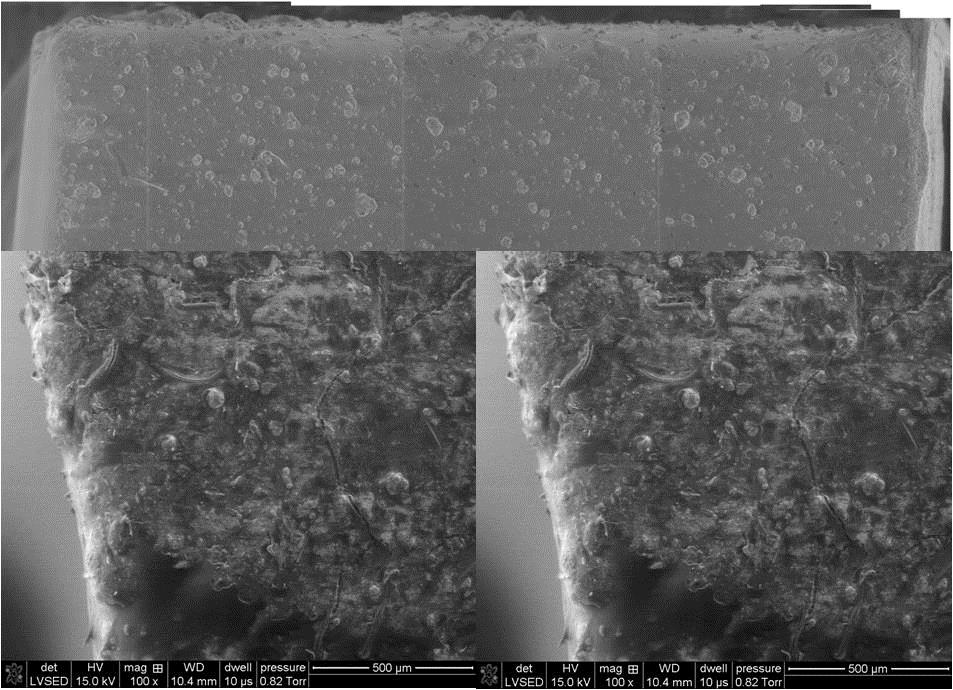 Present work is aimed at the development of multiple cross-validated
test procedures to identify time-dependent viscoelastic behavior
of compliant TIMs and to correlate the mechanical response of
the materials to experimentally measured effective thermal
conductivity. Exhaustive viscoelastic characterization of the
Gap pad (compliant TIM) materials, and relating mechanical
cycling to measured thermal conductivity degradation of these
materials have been accomplished. This research also estimated
the stress transmitted to the solder joints through the gap pads
as a result of applied pressures during heatsink assembly. The
top figure is a cross-section of the chosen TIM as viewed under
environmental mode in a scanning electron microscope showing a
fiberglass pad on right side of the image. The lower two figures
are the chosen material also view.
Present work is aimed at the development of multiple cross-validated
test procedures to identify time-dependent viscoelastic behavior
of compliant TIMs and to correlate the mechanical response of
the materials to experimentally measured effective thermal
conductivity. Exhaustive viscoelastic characterization of the
Gap pad (compliant TIM) materials, and relating mechanical
cycling to measured thermal conductivity degradation of these
materials have been accomplished. This research also estimated
the stress transmitted to the solder joints through the gap pads
as a result of applied pressures during heatsink assembly. The
top figure is a cross-section of the chosen TIM as viewed under
environmental mode in a scanning electron microscope showing a
fiberglass pad on right side of the image. The lower two figures
are the chosen material also view.
Enhanced Thermal Contact Conductance Using Carbon Nanotube Interfaces
 A tri-layer catalyst configuration has been developed for well
anchored and vertically oriented CNT arrays direct synthesized
on various substrates with plasma-enhanced chemical vapor
deposition and different catalyst metals. A test rig for thermal
contact resistance measurement (adapted from ASTM D 5470) has
been established in a high-vacuum environment, and temperature
measurements are accomplished with an infrared imaging system.
The figure above summarizes thermal interfacial resistance
results for a bare copper-silicon interface, a single-sided CNT
array, and a double-sided array. The results demonstrate that
the CNT arrays can exhibit resistances below 10 mm2K/W that are
comparable to the resistance of an ultra-thin soldered joint.
A tri-layer catalyst configuration has been developed for well
anchored and vertically oriented CNT arrays direct synthesized
on various substrates with plasma-enhanced chemical vapor
deposition and different catalyst metals. A test rig for thermal
contact resistance measurement (adapted from ASTM D 5470) has
been established in a high-vacuum environment, and temperature
measurements are accomplished with an infrared imaging system.
The figure above summarizes thermal interfacial resistance
results for a bare copper-silicon interface, a single-sided CNT
array, and a double-sided array. The results demonstrate that
the CNT arrays can exhibit resistances below 10 mm2K/W that are
comparable to the resistance of an ultra-thin soldered joint.
Thermal and Electrical Characterization of CNT Vias
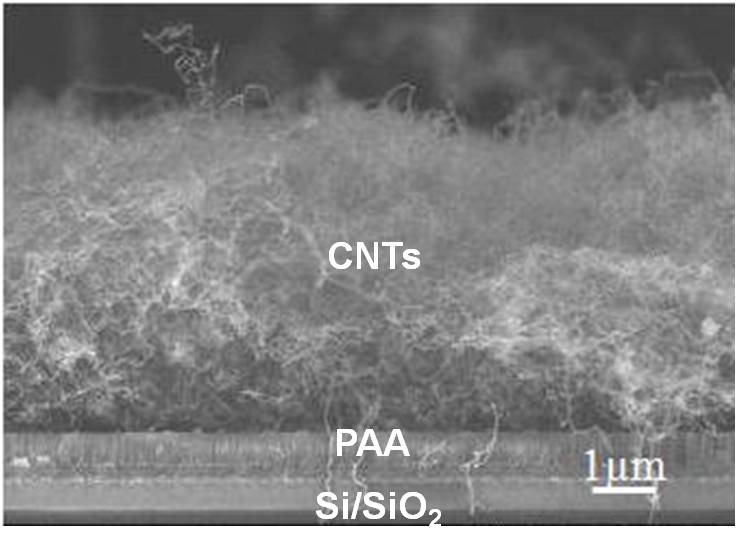 CNTs with their unique combination of high current carrying capacity,
high thermal conductivity, mechanical integrity and electron
mean free paths of several microns may be ideal candidates for
next-generation interconnects. In this project, stable and dense
CNTs were grown from electrodeposited Pd in the bottom of porous
anodic alumina (PAA) pores, using buckypaper as a plasma screen.
CNT density was calculated to be up to 1.0x1010 cm-2,
and the minimum current density transported in CNT vias was
calculated to be 106 A/cm2, which is
comparable to or higher than Cu interconnects. Modifications to
CNTs by electron donating and electron withdrawing chemicals
(e.g., TTF and TCNE) have been made to improve the electrical
properties of CNT vias. The first figure shows a side view of
as-grown CNT's using Pd as catalysts.
CNTs with their unique combination of high current carrying capacity,
high thermal conductivity, mechanical integrity and electron
mean free paths of several microns may be ideal candidates for
next-generation interconnects. In this project, stable and dense
CNTs were grown from electrodeposited Pd in the bottom of porous
anodic alumina (PAA) pores, using buckypaper as a plasma screen.
CNT density was calculated to be up to 1.0x1010 cm-2,
and the minimum current density transported in CNT vias was
calculated to be 106 A/cm2, which is
comparable to or higher than Cu interconnects. Modifications to
CNTs by electron donating and electron withdrawing chemicals
(e.g., TTF and TCNE) have been made to improve the electrical
properties of CNT vias. The first figure shows a side view of
as-grown CNT's using Pd as catalysts.
Validated Models for Particulate Thermal Interface Materials
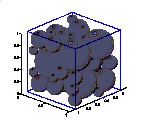 Numerical modeling of realistic 3D microstructures (at high filler volume
loadings) considering inter-particle interactions was performed
using full-field meshless simulations and random particle
network simulations. The developed models are validated with
experiments on representative systems. The models can be
efficiently used to accurately predict the effect of varying: i)
the filler particle conductivity, ii) the base polymer matrix
conductivity, and iii) size-distribution and arrangement of the
filler particles on the composite thermal conductivity of TIMs.
Numerical modeling of realistic 3D microstructures (at high filler volume
loadings) considering inter-particle interactions was performed
using full-field meshless simulations and random particle
network simulations. The developed models are validated with
experiments on representative systems. The models can be
efficiently used to accurately predict the effect of varying: i)
the filler particle conductivity, ii) the base polymer matrix
conductivity, and iii) size-distribution and arrangement of the
filler particles on the composite thermal conductivity of TIMs.
Thermal Cycling Fatigue Effects on the Contact Resistance of Organic Interface Materials on Si
The development of an
accurate constitutive model of the effect of thermal cycling to
polymer interface layers will be necessary for the reliable
integration of organic materials into high performance packages.
Accurate measurements of heat flow are dependent upon knowing
and controlling the ambient operating conditions. Mapping the
development of interface defects is important for improving the
materials which aid in the removal of heat from electronic
packages. Finding and documenting the evolution of the defects
is dependent upon a full understanding of the thermal probes
response to changing environmental conditions. Changes in test
operating conditions can dominate changes to local interface
properties.



